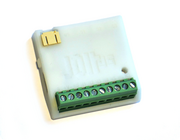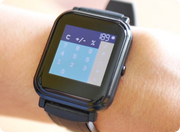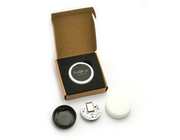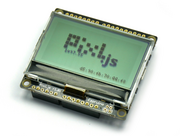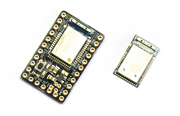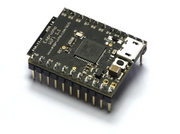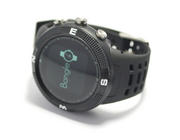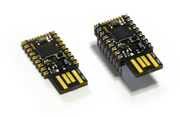Pixl.js Multicolour
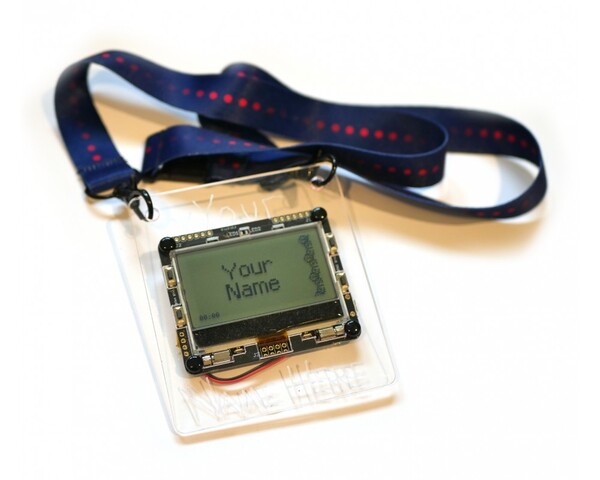
Buy Now
From £45
Espruino ShopA special version of the Pixl.js Smart LCD with multicolour LEDs, sensors and a rechargeable battery.
Contents
💡This code can be uploaded in a few clicks with the Espruino App loader
Quick Links
- Original Nodeconf badge pages
- GitHub Repo (code, schematics, board layout)
- Espruino Bluetooth Getting Started
- Espruino Pixl.js info
- Returning your badge to normal
Firmwares
- Upload firmware direct from the Espruino App Loader
- Simple Badge firmware
- The Nodeconf EU Badge's default firmware
Getting Started
The badge is based on a Pixl.js, so a lot of the tutorials and information there still apply.
The button names can be hard to read because of the badge surround, but they are as follows:
...... ......
___________________________
BTN1 | | BTN2
| |
| |
| |
BTN4 |___________________________| BTN3
::::
There is an on/off slider switch on the rear of the badge just by the USB connector (which is used for charging only).
Bugs!
- On some of the badges, the vibration caused by the vibration motors during startup can cause the LED controller to stop working. If when you power your badge on it doesn't go through all the colours of the rainbow, power it on with your thumbs over the vibration motors at the bottom left and right of the screen. This should be fixed on badges produced after Nodeconf 2018
- If your badge stops animating while in badge mode, try just pressing a button and it should spring back to life (updating the actual Espruino firmware can fix this - see Updating Espruino below).
- When you charge the badge via USB, the on/off switch on the back needs to be set to ON (with the sticky-out part nearest the USB connector) or the battery won't charge. This is not required on badges produced after Nodeconf 2018
- If you're writing bits of code using
require("Storage").write('.boot...')you may eventually get errors about not being able to write (the same can happen when trying to change settings). You can solve this by following the Returning your badge to normal instructions - but Updating Espruino can stop it happening again as well.
Connecting
To avoid a complete free-for-all when many badges are used, when the badges start up they disable the ability to connect to them. To connect, you must do one of:
- Go to the
Make Connectablemenu item - Power the badge off, and power it on with
BTN2orBTN3held down. The badge firmware will be loaded, but your badge will be connectable. - (Not recommended) Power the badge off, and power it on with
BTN1held down while the bootloader percent bar goes to the end, then release when told. Do not keep holding the button down or all saved badge code will be erased.. This initialises a self test, which will fail (because the board isn't quite a standard Pixl.js). This will start your badge without loading any of the badge code.
You can then use the Chrome web Browser on any Windows 10 or Mac OS device
and go to https://www.espruino.com/ide and you can connect.
You're looking for a device called Pixl abcd where abcd are the last 4
characters of the MAC address shown on the Badge's screen.
If you used Espruino before, ensure that the Save on Send option in the
Communications part of the Web IDE's settings is set to To RAM otherwise
you'll overwrite the badge firmware.
Using your own Editor
You can use the Espruino CLI:
npm install -g espruino
# abcd = last 4 digits displayed on your badge
espruino -d abcd --config RESET_BEFORE_SEND=false -w filename.js
The -w filename,js option watches that file for changes, so the connection
to the badge (and REPL) will be maintained and every time you save the file
in your editor it'll automatically upload.
In this case the CLI tool will upload to RAM without resetting the device, so writing an app like this will allow you to quickly test your code:
Badge.apps["My App"] = ()=>{
// Reset everything on the badge to a known state
Badge.reset();
// Display a menu
Pixl.menu({ "": { "title": "-- A Test --" },
"LED1 on" : ()=>LED1.write(1),
"LED1 off" : ()=>LED1.write(0),
"Back to Badge":Badge.badge
});
};
// automatically run app for testing
Badge.apps["My App"]();
Returning to Standard
- Click this link in Chrome for the nodeconf firmware
- OR Click this link in Chrome for the simple firmware
- Change
Badge.NAME = ...to["Your", "Name"]- each array element is a new line - Connect to your badge (see above)
- If you're having trouble connecting, power your badge on with
BTN1held down for ~10 seconds (until a message about code being erased is shown) - this will remove all code from the badge and make it connectable - ready for you to re-upload the badge code. - Optional: Type
require("Storage").eraseAll()in the left hand side of the IDE. This will remove all data from nonvolatile storage. - Turn the
Save on Sendoption in theCommunicationspart of the Web IDE's settings toDirect To Flash - Upload the code
- Return the
Save on Sendoption in theCommunicationspart of the Web IDE's settings toTo RAMso you don't accidentally overwrite the code in the future.
You're sorted!
Stuff to do
On the badge, you have a bunch of stuff you can use. Most of it is available via NC
in a global variable created by the badge software. If you're trying to
do things on your own without the badge software, use var NC = require("nodeconfeu2018");
first.
Bluetooth
Check out the Pixl.js page for examples.
LED1, LED2
You can turn the LEDs on and off with digitalWrite(LED1,1) or LED1.write(1). Use 0 to turn them off.
RGB lighting
The badge has fancy RGB lighting. There's:
- LEDs facing up - Change these with
NC.ledTop([R,G,B])orNC.ledTop()/NC.ledTop([0,0,0])to turn them off - LEDs facing down - Change these with
NC.ledBottom([R,G,B])orNC.ledBottom()/NC.ledBottom([0,0,0])to turn them off - LCD backlight with 4 zones - Change this with
NC.backlight([B,G,R,B,G,R,B,G,R,B,G,R])orNC.backlight()/NC.backlight([0,0,0])to turn them off
In the above code, B/G/R are numbers between 0 and 255 and represent Blue, Green and Red.
Light sensor
LED2 can be used as an ambient light sensor - just use NC.light() to get
a reading between 0 and 1.
It will definitely be thrown off by any light from any of the other on-badge LEDs.
Vibration
You can use the vibration motors just like normal pins on Espruino...
// Use VIBL/VIBR for left and right motors
// Motor on
digitalWrite(VIBL,1);
// Motor off
digitalWrite(VIBL,0);
// Pulse motor on for 100ms
digitalPulse(VIBL,1,100);
// Pulse motor 3 times, for 100ms, with 150ms between each pulse
digitalPulse(VIBL,1,[100,150,100,150,100]);
// Or slowly ramp the speed of the motor up and down
var n = 0;
setTimeout(function cb() {
analogWrite(VIBL,Math.sin(n));
n+=0.01;
if (n<Math.PI) setTimeout(cb,20);
else digitalWrite(VIBL,0);
}, 20);
Sound
The vibration motors can also be used to create (reasonably quiet) sounds.
analogWrite(VIBL,0.05,{freq:2000}); // Make sound!
There are some very simple examples at http://www.espruino.com/Making+Music
that will work on the vibration motor - just make sure that the second argument
of analogWrite (the duty cycle) is low enough that the vibration motor isn't
turning!
Accelerometer
console.log(NC.accel());
// {x,y,z}
Magnetometer
console.log(NC.mag());
// {x,y,z}
LiPo
NC.getBatteryState()
// { charging:bool, standby:bool}
Extending the badge
You can add your own 'Apps' or LED patterns that will display in the Badge's
memory just by adding them to the Badge.patterns or Badge.apps arrays.
Normally when you upload code from the right-hand side of the IDE it will reset
the badge (this won't remove saved code, but will stop the badge code from running).
To avoid this, either copy/paste your code from the right-hand side of the IDE
to the left, or disable the Reset before send option in the Communications part
of the Web IDE's settings.
Patterns
Just do something like:
// LED patterns - each is [callback, period_in_ms]
Badge.patterns.blue=()=>{ var n=0;return [()=>{
var c = [127,0,0];
NC.ledTop(c);
NC.ledBottom(c);
NC.backlight(c.concat(c,c,c));
},0];};
And you can test by running Badge.pattern("mine").
The above example will only be called once because it returns 0 for period_in_ms,
but you can easily supply a different value to be called more often:
Badge.patterns.green=()=>{ var n=0;return [()=>{
n+=50;
if (n>1536)n=0;
NC.ledTop([0,Math.max(255-Math.abs(n-1024),0),0]);
NC.ledBottom([0,Math.max(255-Math.abs(n-1384),0),0]);
NC.backlight([0,Math.max(255-Math.abs(n-640),0),0,
0,Math.max(255-Math.abs(n-512),0),0,
0,Math.max(255-Math.abs(n-384),0),0,
0,Math.max(255-Math.abs(n-256),0),0]);
},50];};
50ms is usually a good balance of battery life and smoothness.
Apps
Just write your app to the Badge.apps array:
Badge.apps["My App"] = ()=>{
// Reset everything on the badge to a known state
Badge.reset();
// Display a menu
Pixl.menu({ "": { "title": "-- A Test --" },
"LED1 on" : ()=>LED1.write(1),
"LED1 off" : ()=>LED1.write(0),
"Back to Badge":Badge.badge
});
};
And you can test by running Badge.apps["My App"]()
To return to normal badge functionality just call Badge.badge() or Badge.menu()
to return to the menu.
Saving...
When you upload code as described above, your function will be loaded into RAM and will be lost when the badge is reset.
To make it persist, you can write it into a file in the badge's storage
called .boot0,.boot1,.boot2 or .boot3 - each one is executed in
turn on boot so you can have more than one extension at once.
require("Storage").write(".boot0",`
Badge=global.Badge||{};
Badge.apps=Badge.apps||{};
Badge.apps["My App"] = ()=>{
// Reset everything on the badge to a known state
Badge.reset();
// Display a menu
Pixl.menu({ "": { "title": "-- A Test --" },
"LED1 on" : ()=>LED1.write(1),
"LED1 off" : ()=>LED1.write(0),
"Back to Badge":Badge.badge
});
};
`);
You can also do things like overwrite the built-in name, without having to overwrite the basic badge firmware.
require("Storage").write(".boot1",`
Badge=global.Badge||{};
Badge.NAME=["Hello","World"];
`);
Common Pitfalls
- If you get
Badge not founderrors while trying to upload an app from the right hand side, it'll be because you're uploading with theReset before sendoption turned on in the IDE settings (it should be turned off) reset()(or 'reset before send) removes all JS code from the badge's RAM (including theBadgeobject) - it can be handy if you want to have full control of everything on the badge. To get back, see the next point...- If you want to get your badge firmware back out of flash memory without power cycling your badge, just type
load()in the left-hand side of the IDE - Calling
Badge.menu()will bring the Badge's menu back up -Badge.badge()goes back to displaying the badge. If you want a button in the app to bring you back to the menu, you can just call:setWatch(Badge.menu, BTN1); Badge.reset()attempts to reset the badge's state (removing watches and intervals) - it's an idea to stick this as the first line in your app to make sure you start from a known state each time.
Soldering Stuff
There are some special GPIO connectors on the badge. These can be accessed with
commands like digitalWrite(D10,1) or analogRead(A0).
J2(Top Left) contains (left to right)GND,D10,D11,D12,D13and3.3vJ1(Top Right) contains (left to right)GND,A0,A1,A2,A3and3.3vJ3(Bottom center) contains the pinout for an ESP8266 ESP01 module. This can also be used for wired serial comms with the badge:
GND NC NC D1(Badge TX)
D0(Badge RX) D9 NC 3.3v
ESP8266 Wiring
On Nodeconf.eu badges, due to a slight mirroring accident, a normal ESP8266 module has to be attached to the FRONT of the badge, slightly covering the display:
However by removing the ESP01's pins and soldering them on the other side of the module, you can fit the ESP01 to the rear of the badge very tidily.
...... ......
___________________________
BTN1 | | BTN2
| |
| ____ |
| | | |
BTN4 |___________| |__________| BTN3
|::::|
----
This is fixed on badges produced after Nodeconf 2018 and the ESP01 module goes on the back of the badge without modification:
...... ......
___________________________
BTN1 | | BTN2
| |
| |
| |
BTN4 |___________________________| BTN3
|::::|
----
Once soldered you can access the internet as follows:
var WIFI_NAME = "...";
var WIFI_PASS = "...";
D9.set(); // power on
Serial1.setup(115200,{rx:D0,tx:D1});
var wifi = require("ESP8266WiFi_0v25").connect(Serial1, function(err) {
if (err) throw err;
console.log("Connecting to WiFi");
wifi.connect(WIFI_NAME, WIFI_PASS, function(err) {
if (err) throw err;
console.log("Connected");
// Now you can do something, like an HTTP request
require("http").get("http://www.pur3.co.uk/hello.txt", function(res) {
console.log("Response: ",res);
res.on('data', function(d) {
console.log("--->"+d);
});
});
});
});
Check out Espruino's page on Internet stuff for more info.
You can now update ESP8266 firmware using the Web IDE.
Firmware Updates
The badges came with Espruino v2.00, but there have been a few changes to Espruino since then that have fixed:
- The badge pausing issue (caused by high Bluetooth LE traffic when scanning)
- Filesystem issues when repeatedly calling
require("Storage").write - Other issues
To update Espruino, just follow the normal Firmware Update instructions with the 'Cutting edge' build linked from the firmware download page.
This'll take a few minutes, and you then need to follow the steps for Returning your badge to normal - so if you're fine with everything as it is, we'd recommend that you keep version 2.00 for now.
Changing your name on the badge in the Web IDE
As an alternative to using the simple Web Bluetooth page to change the name, you can also do the following:
- On the badge, press the top left button, then select "Make Connectable" from the menu and note the last four hex digits of the address of the badge
- Click this link in Chrome to open the Online IDE with the correct code
- In that code, edit the two fields "Bob" and "Loblaw" to whatever you need.
- Click the yellow Connect button in the top left corner of the IDE
- Click "Web Bluetooth" in the pop-up
- Click your device name
- Once connected, click the "Send to Espruino" button in the middle of the IDE
- Reboot your badge and you'll see the new name
Other Official Espruino Boards
This page is auto-generated from GitHub. If you see any mistakes or have suggestions, please let us know.
